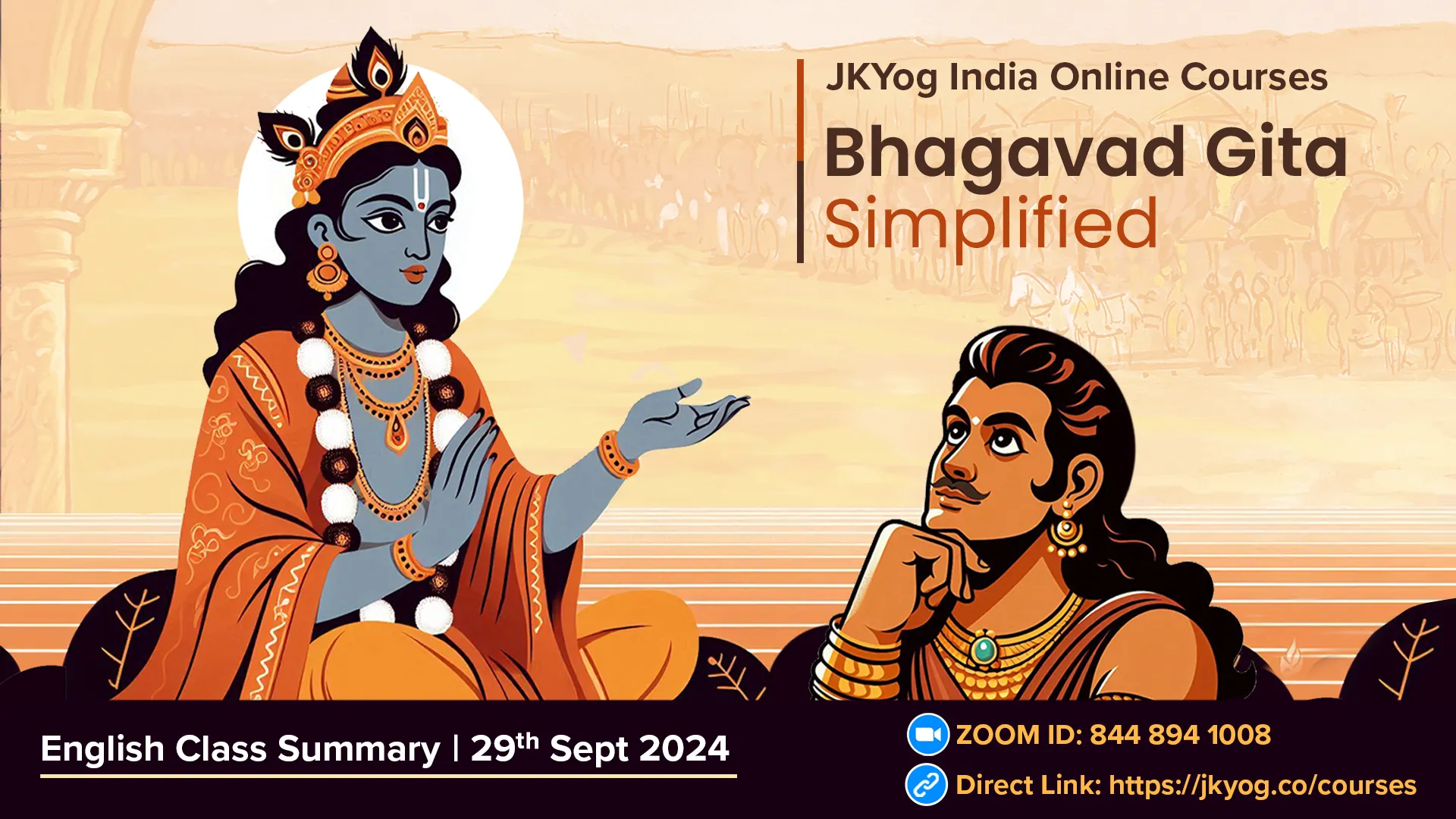In Class 16 of the Bhagavad Gita, Shree Krishna explains the three guna (modes of material nature) — sattva (goodness), rajas (passion), and tamas (ignorance) — and how they affect the body, mind, and intellect. These gunas bind the soul to material existence, influencing our thoughts, actions, and, ultimately, our destiny. Shree Krishna also reveals how to transcend these modes and reach the ultimate goal of union with the Divine.
The Three Guna: Sattva, Rajas, and Tamas
Material nature consists of the three guna—sattva, rajas, and tamas. These modes arise from Prakriti (material nature) and affect the mind, intellect, and body, shaping an individual's personality and behaviour.
- Sattva (Goodness)
Sattva is the mode of goodness characterised by purity, knowledge, and well-being. It binds the soul through attachment to happiness and knowledge.
तत्र सत्त्वं निर्मलत्वात्प्रकाशकमनामयम् |
सुखसङ्गेन बध्नाति ज्ञानसङ्गेन चानघ ||
"Amongst these, sattva guṇa, the mode of goodness, being purer than the others, is illuminating and full of well-being. O sinless one, it binds the soul by creating attachment for a sense of happiness and knowledge." (BG 14.6)
When sattva predominates, individuals feel light, joyful, and serene. It promotes clarity, wisdom, peace, and virtue. Characteristics such as morality and peacefulness are hallmarks of those in sattva. - Rajas (Passion)
Rajas is the mode of passion, arising from desires and attachments, and it binds the soul through attachment to actions and their results.
रजो रागात्मकं विद्धि तृष्णासङ्गसमुद्भवम् |
तन्निबध्नाति कौन्तेय कर्मसङ्गेन देहिनम् ||
"O Arjun, rajo guṇa is of the nature of passion. It arises from worldly desires and affections and binds the soul through attachment to fruitive actions." (BG 14.7)
Rajas is responsible for activity in both the body and mind, leading to restlessness, numerous desires, and a feeling of being overwhelmed. It is linked to desire, activity, attachment, and restlessness. - Tamas (Ignorance)
Tamas is the mode of ignorance, leading to delusion, laziness, and darkness. It binds the soul through attachment to negligence, laziness, and sleep.
तमस्त्वज्ञानजं विद्धि मोहनं सर्वदेहिनाम् |
प्रमादालस्यनिद्राभिस्तन्निबध्नाति भारत ||
"O Arjun, tamo guṇa, which is born of ignorance, is the cause of illusion for the embodied souls. It deludes all living beings through negligence, laziness, and sleep." (BG 14.8)
Associated with delusion, laziness, and inertia- tamas leads individuals into a state of lethargy, confusion, and ignorance.
How the guna Bind the Soul
The guna influences the kṣhetra (body) and the mind, determining an individual's behaviour, actions, and future destiny. All three guna bind the soul, but in different ways:
- Sattva binds one to material happiness.
- Rajas binds one to actions and desires.
- Tamas binds one to delusion and ignorance.
सत्त्वं सुखे सञ्जयति रज: कर्मणि भारत |
ज्ञानमावृत्य तु तम: प्रमादे सञ्जयत्युत ||
"Sattva binds one to material happiness; rajas conditions the soul toward actions; and tamas clouds wisdom and binds one to delusion." (BG 14.9)
The dominance of each guna changes based on time, circumstances, and actions, leading to various life outcomes.
Effects of the Dominance of Each Guna
The interplay of the guna determines the quality of an individual's experiences. When sattva prevails, rajas and tamas recede. When rajas dominates, sattva and tamas take a backseat, and similarly, when tamas is dominant, sattva and rajas become less impactful.
These modes also influence other aspects of life, such as food, actions, and attitudes:
- Sattvic food: Promotes purity, health, and vitality.
- Rajasic food: Creates excitement, passion, and restlessness.
- Tamasic food: Leads to lethargy, dullness, and inertia.
The guna predominant at the time of death determines one's next birth:
यदा सत्त्वे प्रवृद्धे तु प्रलयं याति देहभृत् |
तदोत्तमविदां लोकानमलान्प्रतिपद्यते ||
रजसि प्रलयं गत्वा कर्मसङ्गिषु जायते |
तथा प्रलीनस्तमसि मूढयोनिषु जायते ||
"Those who die with a predominance of sattva reach the pure abodes (which are free from rajas and tamas) of the learned. Those who die with the prevalence of the mode of passion are born among people driven by work, while those dying in the mode of ignorance take birth in the animal kingdom." (BG 14.14-15)
- Sattva: Leads to higher realms or births of wisdom and virtue.
- Rajas: Leads to human birth with continued desire-driven activity.
- Tamas: Leads to lower births, such as in the animal kingdom.
How to Transcend the gunas
Shree Krishna reveals the key to overcoming the three gunas and attaining liberation lies in detaching from their influence and attaching oneself to the Supreme Lord.
नान्यं गुणेभ्य: कर्तारं यदा द्रष्टानुपश्यति |
गुणेभ्यश्च परं वेत्ति मद्भावं सोऽधिगच्छति ||
"When wise persons see that in all work there is no agent of action other than the three gunas, and they know Me to be transcendental to these gunas, they attain My divine nature." (BG 14.19)
The Supreme Lord is tri-guṇātīt—beyond the influence of the guna. Attaching the mind to worldly objects strengthens the influence of the gunas while attaching the mind to the divine realm through bhakti helps transcend the guna and attain divinity.
By transcending the modes of material nature, one becomes free from the cycle of birth, death, old age, and misery, ultimately attaining immortality:
गुणानेतानतीत्य त्रीन्देही देहसमुद्भवान् |
जन्ममृत्युजरादु:खैर्विमुक्तोऽमृतमश्रुते ||
"By transcending the three modes of material nature associated with the body, one becomes free from birth, death, old age, and misery and attains immortality." (BG 14.20)
Characteristics of a Liberated Soul (Gunateet)
Shree Krishna describes the characteristics of an individual who has transcended the guna:
- Transcending the three guna: Liberated individuals recognise that the guna are not their true selves and rise above their influence.
- Neutrality to the Modes: They maintain equanimity and detachment, not resenting or desiring the presence or absence of the guna.
- Established in the Self: Rooted in their true identity, the self (Atman), they remain unaffected by the fluctuations of the mind.
- Detached Action: They perform their duties without attachment to outcomes, focusing on self-purification and leaving the results to God.
- Mind vs. Self: They recognise that the guna influences the mind and dissociates from negative thoughts, staying spiritually grounded.
Ultimate Goal: Union with the Divine
The ultimate goal is to transcend the guna and achieve union with the Divine. This can be accomplished through unalloyed devotion to Shree Krishna.
मां च योऽव्यभिचारेण भक्तियोगेन सेवते |
स गुणान्समतीत्यैतान्ब्रह्मभूयाय कल्पते ||
"Those who serve Me with unalloyed devotion rise above the three modes of material nature and come to the level of the Brahman." (BG 14.26)
To transcend the guna, one must focus the mind on Shree Krishna through bhakti yog. This devotion allows individuals to achieve a state of being nirguṇa (untouched by the three modes), similar to Krishna's own nature.
ब्रह्मणो हि प्रतिष्ठाहममृतस्याव्ययस्य च |
शाश्वतस्य च धर्मस्य सुखस्यैकान्तिकस्य च ||
"The Supreme Lord is the source of the eternal, imperishable Brahman. Those who transcend the guna through devotion merge with the Supreme, attaining the ultimate state of bliss and freedom from material bondage." (BG 14.27)
Shree Krishna refutes the misconception that only attachment to the formless Brahman leads to transcendence. The personal form of God is also nirguṇa, despite having infinite divine qualities.
Key Learnings from Today's Class
- Influence of the Three guna
The three guna—sattva (purity), rajas (activity), and tamas (inertia)—shape our thoughts, actions, and emotions. Sattva brings clarity and joy, rajas causes restlessness and desire, and tamas leads to ignorance and lethargy. - Binding Nature of the guna
The guna bind the soul through attachment, keeping it trapped in the cycle of rebirth. - Transcending the guna
Detaching from the guna and attaching to the Supreme Lord through bhakti allows for transcendence and liberation. - Traits of a Liberated Soul
A liberated soul remains unaffected by the guna, embodying balance and peace. - Ultimate Goal
The goal is to rise above the guna and achieve union with the Divine for Spiritual liberation.
Summary: JKYog India Online Class- Bhagavad Gita Simplified [English]- 29th September 2024








